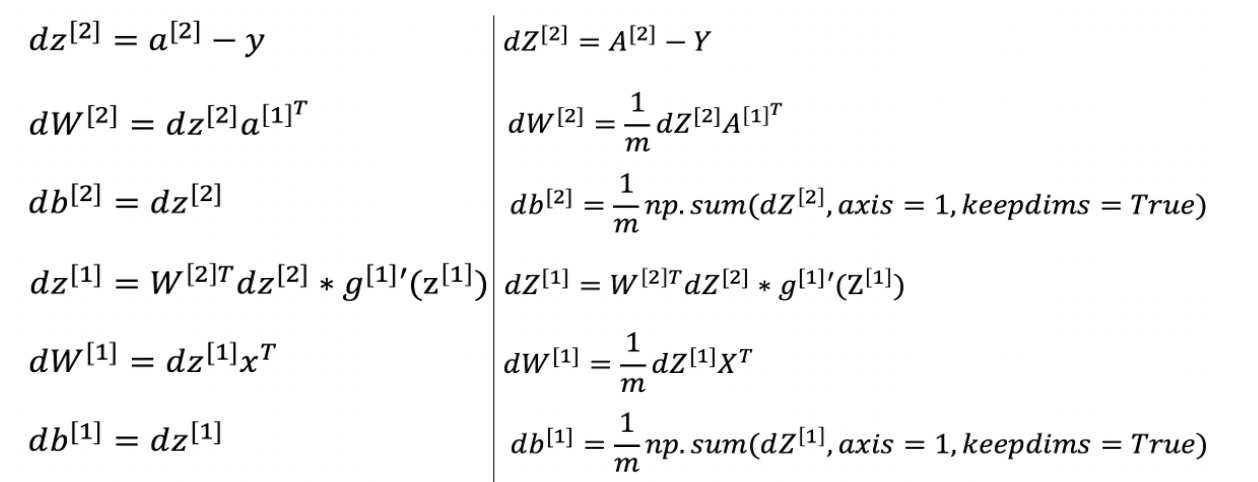class 2 : Logistic Regression with a Neural Network mindset
1. 提取数据(图片)维度
m_train = train_set_x_orig.
shape[0]
num_px = train_set_x_orig
.shape[1]
print ("train_set_x shape: " + str(train_set_x_orig.shape))
Each image is of size: (64, 64, 3)train_set_x shape: (209, 64, 64, 3)
2. 将矩阵转为列向量堆叠
train_set_x_flatten = train_set_x_orig.
reshape(train_set_x_orig.shape[0],
-1
).T
train_set_x = train_set_x_flatten/255
数据标准化
3. 初始化W,b
initialize_with_zeros(dim)
w = np.zeros((dim,1))
b = 0
注意用assert检查数据类型和矩阵维度
assert(w.shape == (dim, 1))
assert(isinstance(b, float) or isinstance(b, int))
4. 前向传播
def propagate(w, b, X, Y):
m = X.shape[1] #注意样本数目所在维度!!
A = sigmoid(np.dot(w.T,X)+b) # X保持维度不变!
cost = -np.sum(Y*np.log(A)+(1-Y)*np.log(1-A))/m # 注意sum用法,最后除以样本总量!
dw = np.dot(X,(A-Y).T)/m
db = np.sum(A-Y)/m
5. 多次迭代
for i in range(num_iterations):
grads, cost = propagate(w, b, X, Y)
w = w-dw*learning_rate
b = b-db*learning_rate
------------------------------------------------------------------------------------------
class 3 : Planar data classification with one hidden layer v5
1. 作图&检查矩阵维度
plt.scatter(X[0, :], X[1, :], c=Y, s=40, cmap=plt.cm.Spectral)
2. 各层维度定义
def layer_sizes(X, Y):
n_x = X.shape[0] # size of input layer
n_h = 4
n_y = Y.shape[0]
3. 参数初始化
def initialize_parameters(n_x, n_h, n_y):
W1 = np.random.randn(
n_h,n_x)*
0.01
b1 = np.zeros((n_h,1))
W2 = np.random.randn(
n_y,n_h)*
0.01
b2 = np.zeros((n_y,1))
4. 前向传播
def forward_propagation(X, parameters):
Z1 = np.dot(W1,X)+b1
A1 = np.
tanh(Z1)
Z2 = np.dot(W2,
A1)+b2 # 这里注意不要写成X!!
A2 =
sigmoid(Z2)
5. 损失计算
def compute_cost(A2, Y, parameters):
logprobs = np.multiply(np.log(A2),Y)+np.multiply(np.log(1-A2),(1-Y))
cost = - 1/m*np.sum(logprobs)
cost = np.squeeze(cost)
6.反向传播
dZ2 = A2-Y
dW2 = 1/m*np.dot(dZ2,A1.T)
db2 = 1/m*np.sum(dZ2,axis=1,keepdims=True)
dZ1 = np.dot(W2.T,dZ2)* (1 - np.power(A1, 2))
dW1 = 1/m*np.dot(dZ1,X.T)
db1 = 1/m*np.sum(dZ1,axis=1,keepdims=True)
7. 参数更新

------------------------------------------------------------------------------------------
class 4 : Building your Deep Neural Network - Step by Step
1. 参数初始化
initialize_parameters(n_x, n_h, n_y) 返回parameters,存入各层的W,b
initialize_parameters_deep(layer_dims)
L = len(layer_dims)
for l in range(1, L):
parameters['W' + str(l)] = np.random.randn(layer_dims[l], layer_dims[l-1]) * 0.01 【注意层数和各层元素初始化之间的关系】
parameters['b' + str(l)] = np.zeros((layer_dims[l], 1))
2. 前向传播
def linear_forward(A, W, b):
Z = np.dot(W,A)+b
cache = (A, W, b) 将该层的输入与参数保存下来
return Z, cache
def linear_activation_forward(A_prev, W, b, activation):
Z, linear_cache = linear_forward(A_prev,W,b)
A, activation_cache = sigmoid(Z)
activation_cache里存的就是Z
cache = (linear_cache, activation_cache)
注意这时候cache存的是两个部分
return A, cache
def L_model_forward(X, parameters):
A = X
L = len(parameters) // 2 # number of layers in the neural network
for l in range(1, L):
A_prev = A
A, cache = linear_activation_forward(A_prev, parameters["W"+str(l)], parameters["b"+str(l)], 'relu')
caches.append(cache)
AL, cache = linear_activation_forward(A,parameters["W"+str(L)], parameters["b"+str(L)], 'sigmoid')
caches.append(cache)
return AL, caches
3. 损失计算
def compute_cost(AL, Y):
m = Y.shape[1]
cost = -1/m*np.sum(np.multiply(Y,np.log(AL))+np.multiply(1-Y,np.log(1-AL)))
cost = np.squeeze(cost)
return cost
4.
反向传播 【难点!重点!】
def linear_backward(dZ, cache):
A_prev, W, b = cache
m = A_prev.shape[1]
dW = 1/m*np.dot(dZ,A_prev.T)
db = 1/m*np.sum(dZ,axis=1,keepdims=True)
dA_prev = np.dot(W.T,dZ)
return dA_prev, dW, db
def linear_activation_backward(dA, cache, activation):
linear_cache, activation_cache = cache
if activation == "relu":
dZ = relu_backward(dA, activation_cache)
dA_prev, dW, db = linear_backward(dZ, linear_cache)
elif activation == "sigmoid":
dZ = sigmoid_backward(dA, activation_cache)
dA_prev, dW, db = linear_backward(dZ, linear_cache)
return dA_prev, dW, db
def L_model_backward(AL, Y, caches):
dAL = - (np.divide(Y, AL) - np.divide(1 - Y, 1 - AL))
current_cache = caches[L-1]
grads["dA" + str(L)], grads["dW" + str(L)], grads["db" + str(L)] = linear_activation_backward(dAL, current_cache, 'sigmoid')
for l in reversed(range(L-1)):
current_cache = caches[l]
dA_prev_temp, dW_temp, db_temp = linear_activation_backward(grads["dA" + str(l+2)], current_cache, 'relu')
grads["dA" + str(l + 1)] = dA_prev_temp
grads["dW" + str(l + 1)] = dW_temp
grads["db" + str(l + 1)] = db_temp
return grads
这个函数应该是有错误在的,最后这一部分没有得分,推导了一下反向求导的逻辑,大致有了了解。
目前比较困惑cache里每一层的数据所存的下标到底是什么,感觉这里有些混乱,应该是导致出错的原因;另外就是对于整个求导的逻辑确实需要再熟悉、明确一下。
5. 参数更新
def update_parameters(parameters, grads, learning_rate):
L = len(parameters) // 2 # number of layers in the neural network
for l in range(L):
parameters["W" + str(l+1)] = parameters["W" + str(l+1)]- learning_rate*grads["dW"+str(l+1)]
parameters["b" + str(l+1)] = parameters["b" + str(l+1)]- learning_rate*grads["db"+str(l+1)]
return parameters
------------------------------------------------------------------------------------------
Deep Neural Network for Image Classification: Application
这一部分基本就是把前面写过的各种函数整体梳理应用一下,贴对函数名字,放对参数就可以,不再赘述。






















 6267
6267

 被折叠的 条评论
为什么被折叠?
被折叠的 条评论
为什么被折叠?








